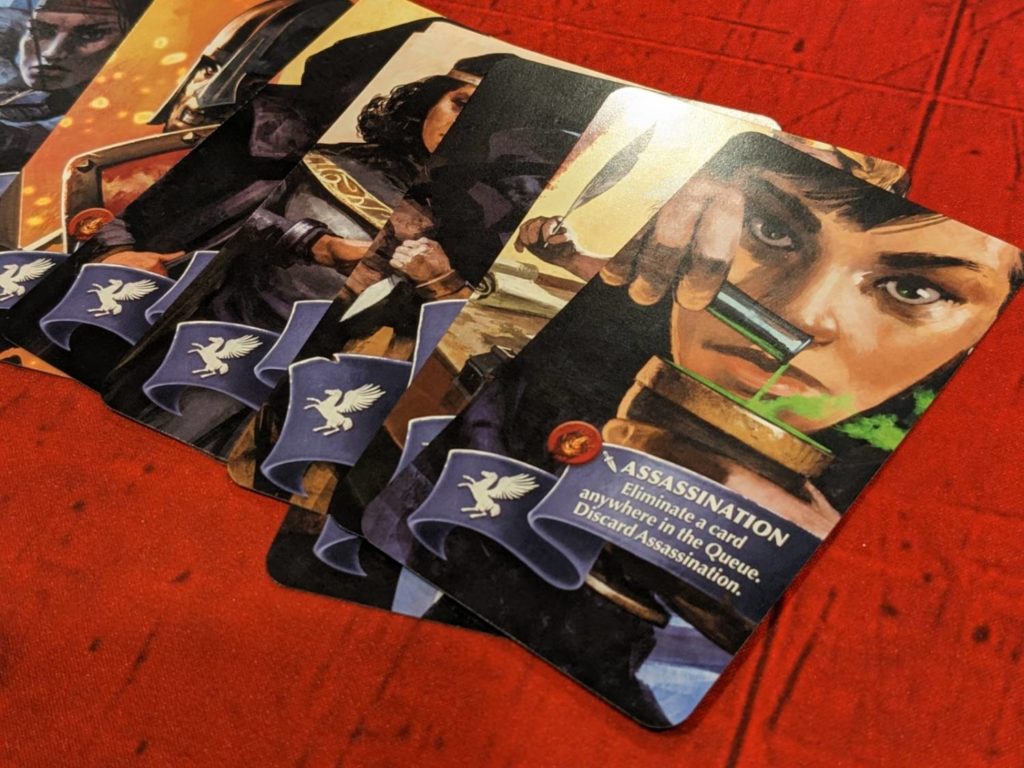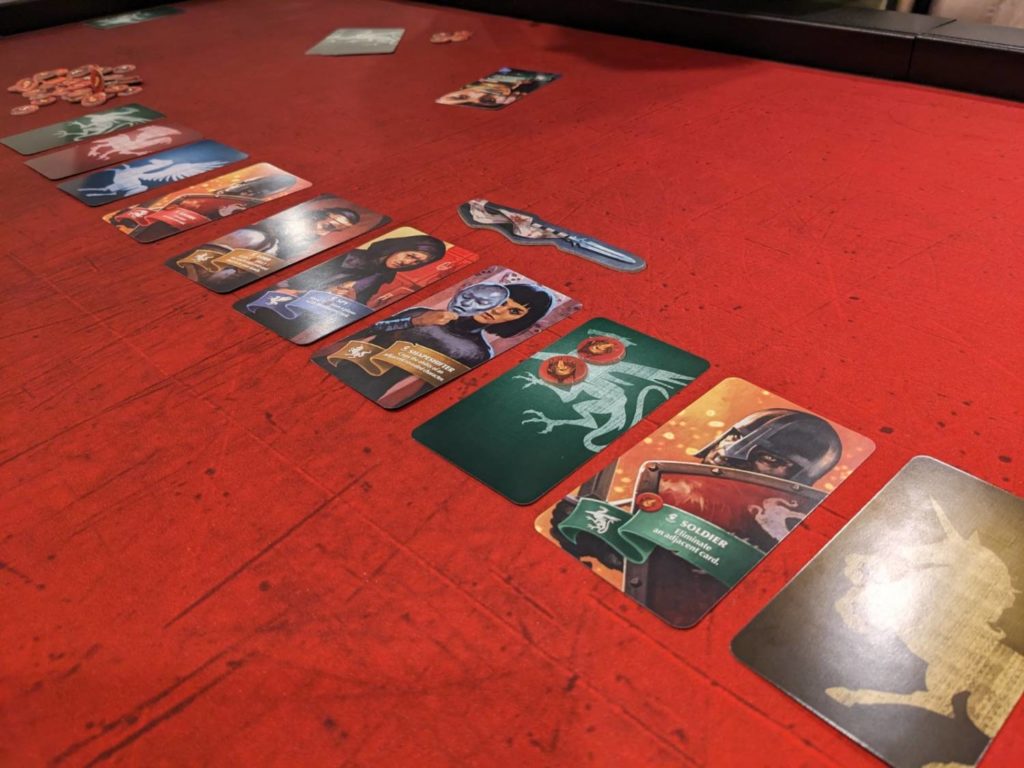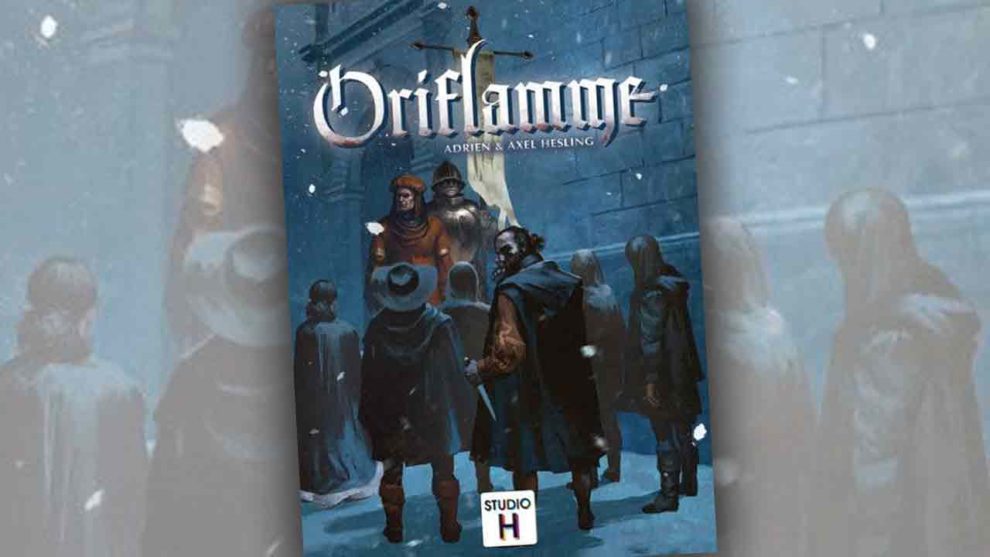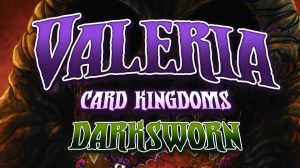Disclosure: Meeple Mountain received a free copy of this product in exchange for an honest, unbiased review. This review is not intended to be an endorsement.
I had the pleasure of playing Oriflamme (Studio H) with friends in early 2021, in between other heavier games one evening. Since I’ll play anything once, I was curious to try a filler that had some elements of hidden cardplay in a 30-minute package.
The cover of Oriflamme tells you quite a bit about the game: a nefarious-looking guy with a look that I think hinted at “I’m about to murder somebody” while others in the background are preparing for something sinister.
That’s the game! Players take on the role of rival families competing for the French royal throne, but Oriflamme feels like something else: a chance to play mind games with some of your best friends (or whoever happens to be sitting at the table).
I got the chance to revisit Oriflamme in preparation for my review of the newest expansion, Oriflamme: Alliance. We didn’t have a review of the base game, so I thought I would share some thoughts on the base experience and why I think it’s an easy addition to almost any game session…assuming you can laugh at the idea of getting robbed, assassinated, and ambushed on nearly every turn, that is.

Could You Pass Me That Knife?
Each player gets a set of 10 cards, with each set identical to what the other players start with. Then players shuffle their individual hand of cards and deal themselves seven of the ten cards for that game, creating some variability from what competitors may have in their hand.
Oriflamme does quite a bit with its brief six-round structure, which is broken into a Placement Phase before a Resolution Phase.
Starting with the first player, each person will play one of their seven cards face down into the Influence Queue, an area in the center of the table. When playing cards, everyone has a choice. Cards can be played at the front of the line, the back of the line, or on top of another card of their family’s suit, if there are any from earlier rounds of the game still in the Queue.
The Queue’s line has a direction, determined during setup by a knife (there’s that knife reference again!!) laid pointing in the Queue. Cards will be resolved in that direction after each player adds a single card during the Placement Phase.
Then, mayhem ensues.
The Resolution Phase kicks off with the owner of each card, starting with the first card in the Queue, making a choice. If the card is currently face down, they can choose to leave their card face down, adding one point (known as Influence) from the supply to the card. Or, they can reveal the card to immediately resolve it.
If a card in the Queue is already face-up (meaning it was revealed in a previous round), the owner resolves that card’s ability immediately.
With only ten unique cards in the game, that must mean these cards are pretty juicy, right? The answer is yes. One card, the Spy, lets you rob a player who owns an adjacent card. Other cards eliminate a card. The Shapeshifter copies a face-up ability of an adjacent card. Assassination does just that, assassinating another card out of the Queue. The Royal Decree lets you move a card anywhere else in the Queue.
As one would expect, the very nature of Oriflamme creates chaos during this phase. It’s a blast, or it’s infuriating, or it’s magical as you watch another player eliminate a rival’s card. One card, Ambush, serves as bait: if anyone eliminates the Ambush card while it is face down, that pays the owner four points, which is quite a large number in Oriflamme.
No matter how you feel, you won’t feel it for very long; after six turns, the game is over. The player with the most Influence wins.

Chicanery, Personified
Oriflamme calls itself a “tactical card game”, and I generally agree with that. When one of the players in my review crew talked about some of the strategic elements of Oriflamme being difficult, I had to laugh. A game featuring this much chaos almost begs to not have a long-term plan at all. Reading and reacting to other players, your current hand, and where you can place a card in the Queue is almost all you can do, although there are some interesting elements of planning as you consider what cards other players have already lost due to eliminations or that might be face up in the current Queue.
Oriflamme has a knife pictured on all four pages of its rulesheet, most of the game’s cards, and all over its box. This is a stabby game, through and through. Preparing a game group for this game requires a disclaimer: “Don’t get comfortable. One of your cards is probably going to be assassinated in the next round or two.” That makes the whole thing easier to stomach.
I know people that love games like this. I like games like this as long as they don’t take long, and they are just funnier with your best friends. “Hey Rob, I’m going to reveal my Soldier card; I’ll eliminate that face-down card of yours and take some Influence from the supply.”
In that regard, the game is a hoot, and the mix of card abilities make for many tense moments, particularly in the third, fourth, and fifth rounds of the game. (The last turn is often anticlimactic, particularly in any game where one player is likely to win running away.) Some of this tension comes from the simple fact that you don’t know which cards each player discarded before play began, and which cards they might be holding for a late-round run at a victory.
Oriflamme is a good time, particularly at four or five players. (Three players is the minimum, but it’s just more interesting with more people yelling at each other.) If you’ve got the right game group, Oriflamme is a solid pick at a reasonable price.












Add Comment